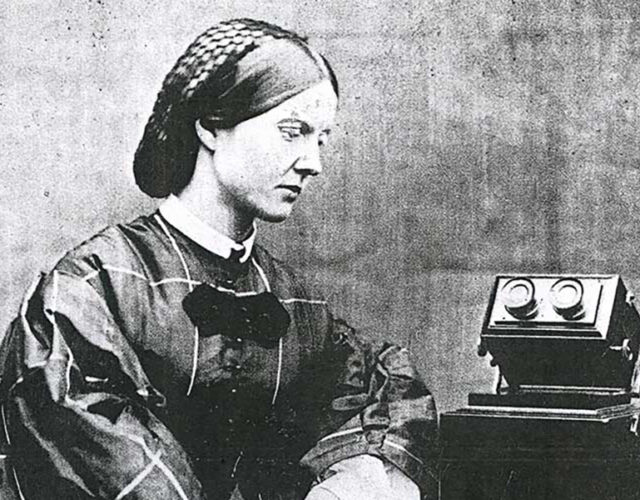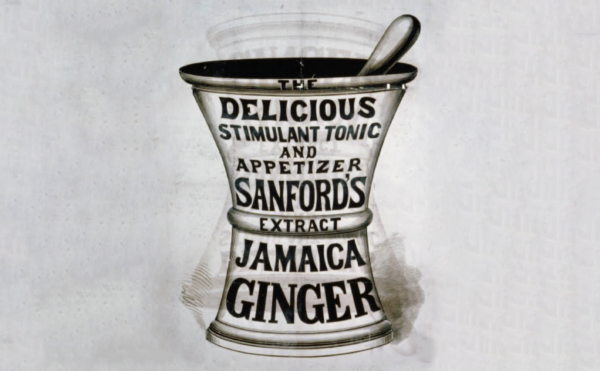In this episode of The Disappearing Spoon, Sam Kean talks about Mary Ward, a budding naturalist and astronomer from Ireland. She spent a lot of time observing plants and animals through a microscope and published a book of detailed sketches that dazzled readers and colleagues in the 1800s. However, her career was cut short by a strange curiosity of that time period: the automobile. They weren’t the same cars that are around today, but her death was the first car death recorded in history, and it foreshadowed the carnage the automobile continues to leave behind.
Credits
Host: Sam Kean
Senior Producer: Mariel Carr
Producer: Rigoberto Hernandez
Audio Engineer: Jonathan Pfeffer
Transcript
In August 1869, Mary Ward badly needed a vacation. She was a slender, sharp-featured 42-year-old with a round nose and dark hair that covered her ears. As an active naturalist and astronomer, she’d been laboring hard to carve out a place for herself in the overwhelmingly male world of Victorian science. She was also raising eight children more or less by herself—which was kind of ridiculous even by nineteenth-century Irish standards.
So just when she was nearing her breaking point, Mary took off to visit her cousin’s castle, located in the Irish midlands west of Dublin. On the journey, her naturalist eye must have appreciated the gorgeous, rolling green hills surrounding the castle.
And while the Irish skies aren’t exactly optimal for astronomy—too many cloudy nights—she must have tingled with excitement to know that the castle could boast of one of the largest telescopes in the world, which she was eager to explore.
The castle also had—believe it or not—a steam-powered automobile.
In the 1860s, automobiles were basically giant toys. People built them in their garages just because they could, for the sport of it. A little more seriously, people were also tinkering with new types of engines, and exploring the bounds of the field of thermodynamics—the same field that was transforming Great Britain and ushering in the Industrial Revolution. So when someone at the castle suggested taking this homemade steam jalopy out for a spin, a scientist like Mary leapt at the opportunity.
Imagine the scene: a rare sunshiny day, a town green, people whistling and clapping as they zoomed by. Death was likely the furthest thing from their minds. But however much people treated cars as toys back then, cars were nevertheless dangerous toys. And sadly, the group’s little lark ended with Mary Ward being crushed under its wheels.
This gave the 42-year-old scientist the dubious distinction of the very first automobile fatality in history—cutting short what might have been, if not for a demanding home life and one errant turn, an even more remarkable career.
Ward got her start in science early. She began collecting butterflies at age three. In 1835, at age eight, she spied Halley’s comet all by herself through a small telescope one night—a discovery she then announced, rather adorably, to the guests at a dinner party her parents were hosting.
Her family also took collecting trips to the peat bogs near her birthplace of Billylin, and cases of insects and feathers and dried flowers began to crowd their walls. Eventually Mary’s father, a pastor who encouraged her interest in science, purchased a high-powered microscope for her for over £48 pounds, roughly $4,200 today.
Microscopes were expensive and fairly exotic instruments then. Before that point, Ward had to rely on weak magnifying glasses instead. The microscope opened a whole new world to her, and she began enthusiastically studying the fine details of different plants and animals, everything from bat hair to the scaly wings of moths to cod eyeballs that she dissected herself and peeled back layer by layer.
This microscope research formed the basis of Ward’s first book, which she both wrote and illustrated. It’s called Sketches with the Microscope—later retitled A World of Wonders Revealed by the Microscope. It took the form of a series of letters to her friend Emily. In the letters, Ward offers both close anatomical analysis of bugs as well as practical advice on using the instrument. And I have to say, I much prefer her warm style of instruction to the rather dry and bloodless style of most scientific papers.
People at the time apparently agreed. The book went through eight editions, and one historian noted that its combination of accessible explanations and lavish drawings, quote, “did as much to make the microscope popular as any other book of the time.” That’s quite an achievement.
Ward’s second book, called Entomology for Sport, was based on a long poem that Ward and her sister Jane wrote during their teenage years. And once again, it managed to blend entertainment and rigor. It included both precise anatomical drawings as well as bits of whimsy, such as a picture of bugs dancing around a floral Maypole.
Meanwhile, Ward kept working in astronomy as well. In yet another book, called Telescope Teachings, she used her artistic skills to produce stunning pictures of different heavenly bodies. Some people compared their crispness to photographs, and they rank among the finest of the era. She also published studies on comets passing through the night sky, as well as the transit of Venus across the Sun.
Although science back then was little more than a good-ol’-boys club, other scientists did pay attention to Ward. For instance, her astronomy work earned her the honor of being one of just three women allowed to receive the monthly bulletin of the Royal Astronomical Society. The other two were the pioneering American astronomer Maria Mitchell, and Queen Victoria herself.
Still, establishing herself in science was an uphill battle for Ward. As a woman, she was barred from both a university education as well as membership in most professional scientific societies, the usual routes to recognition then. Even her widely read first book had been printed privately at first, apparently because no one would publish a scientific book by a woman. Only when sales jumped did a London publishing house snap it up. Overall, Ward’s success is a testament to her perseverance.
Perhaps most amazing of all, Ward did all this work while enduring 11 separate pregnancies—including one stillbirth and two miscarriages. And she did all that in just 13 years of marriage.
Her husband Henry was an army captain—weak-chinned and be-mustached, with curious tufts of hair spiraling out from over his ears. He’d been born into the aristocracy, and was the younger brother of a viscount.
But after retiring from the military, Henry became a gentleman of leisure and never worked again. And unfortunately, he hailed from one of those branches of the aristocracy that, however rich in titles and prestige, was rather poor in terms of cash flow. Honorifics couldn’t pay for childcare, and Ward therefore had to raise all eight of her surviving children more or less alone.
The husband did have an inheritance. But as it dwindled, year by year, baby by baby, the family was forced squeezed into a series of increasingly dilapidated rental properties. Productive as Ward was, she always had to fit her science around her domestic duties.
The lack of time and money had to be even more galling to her considering that one of her cousins spent lavishly on his own research. William Parsons was the 3rd Earl of Rosse <“ross”>. He owned a castle near the town of Birr, roughly 10 miles from Ward’s birthplace.
The castle was reportedly somewhat ugly—an Janus-faced mix of Gothic style on one side and classical Greek style on the opposite side, since the original owner and his wife couldn’t agree on a style that suited both. Still, it must have held a special place in Mary Ward’s heart, since it boasted the world’s largest telescope in the second half of the nineteenth century.
Nicknamed the “leviathan of Birr,” the telescope stretched fifty feet long, and its six-foot-wide mirror weighed four tons. The science-fiction writer Jules Verne even mentioned the leviathan telescope in a novel of his, called From the Earth to the Moon.
The Earl also indulged himself in building the heavy machinery of the Industrial Revolution. Wary visitors remember furnaces belching out black coal smoke as they approached his castle.
Unfortunately, this love of heavy machinery ended up dooming the Earl’s cousin Mary. In the late 1860s, Parsons hand-built one of the world’s first automobiles. Just like the most advanced engines of the day, the car was steam-powered, not gasoline powered. It was fabricated from black metal, with a body shaped like a big oil drum lying on its side. A sort of chimney on top release steam pressure.
Rather the modern design of four rubber wheels, this car had three thick wheels made of iron to battle the bumpy local roads. There was one small wheel up front, and two large ones in the rear—like a reverse of those penny-farthing bicycles that were so popular in the late 1800s.
So in August 1869, when Ward visited the castle and someone suggested taking the steam-mobile out for a spin, she no doubt said yes in a heartbeat.
Unfortunately, four other people wanted to ride as well. And instead of making them wait, Mary’s cousin let them all pile on.
Now, there’s no record of who exactly sat where. But you probably won’t be surprised to know that cousin William, in addition to all his other technological toys, also lavished his riches on the nascent technology of photography. So pictures of the car do exist. You can see these pictures, as well as some stunning drawings from Mary’s scientific work, at patreon.com/disappearingspoon.
The photographs of the steam-mobile show barely enough room for three people on the front bench, so the car was likely overcrowded that day. There was a back bench, too, but that didn’t exactly look safe, either. People would have had to sit with their legs dangling just inches from the ground.
On their lark that day, they put-put-putted out from the castle and headed toward the village of Birr. There, they decided to circle the town green. According to one witness, the driver was “traveling at an easy pace” as he approached St. Brendan’s church there. That was the planned turnaround point, so he cranked the steering wheel and started to round the corner.
What happened next remains obscure to this day. Perhaps they hit a rock or pothole. Perhaps they weren’t actually traveling as such an “easy pace.” Perhaps homemade cars in 1869 just didn’t turn smoothly.
Regardless, the overcrowded carriage jolted during the turn. And during this jolt, Ward was tossed into the air, as if she’d been thrown from a bucking bronco. A second later she hit the ground. And a second after that, one of the huge iron wheels crushed her.
A local doctor arrived within two minutes of the accident. But it already was too late. The wheel had broken Ward’s neck and jaw. Her lips were badly cut, and she was bleeding from the ears. The doctor later said that she’d no doubt fractured her skull—an injury with a high probability of death back then.
As the doctor looked on, helpless, Ward’s face turned ugly grey colors, and her tongue began twitching every time she tried to breathe. Within a minute of the doctor’s arrival, she was dead. According to family lore, the car was dismantled and possibly buried under the courtyard of the castle, never to run again.
Mary Ward’s death was especially poignant considering what happened to her family. A dozen years after her death, her husband’s older brother died. The brother had no children, which meant that Mary’s widower husband inherited the title of viscount—along with all the trappings of a peer. Suddenly the Ward family had money—not to mention a fine estate, and servants to help cook and care for the children. She would have been free from drudgery at last.
In the years she did have, Ward’s scientific output was impressive enough. But if the seating arrangement on the steam car been different that day—and if she had lived to enjoy, à la Virginia Woolf, a lab of her own—there’s no telling what Ward might have accomplished.
After Ward, another person would not die in an automobile accident until, depending on the source you see, either 1896 or 1898—nearly thirty years. Since then, of course, tens of millions of people have died in accidents across the globe, and 1.3 million more join them every year. It’s a carnage matched by few other inventions in history.
But this very first automobile death still stands out—not only for its novelty but for prematurely snuffing out one of the rare female stars of Victorian science.




